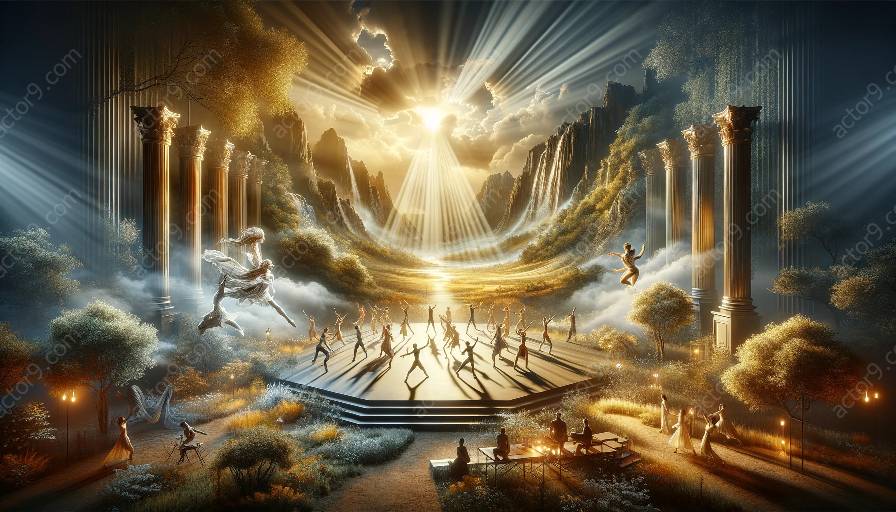Physical theatre is a captivating art form that combines movement, gesture, and expression to convey stories and emotions. The use of lighting in physical theatre plays a significant role in enhancing the overall impact of the performances. Lighting design in physical theatre is a sophisticated and intricate craft that can evoke specific moods and emotions, ultimately shaping the audience's experience. This article explores the key elements of the role of lighting in physical theatre and how it can be leveraged to create impactful and immersive experiences.
The Art of Physical Theatre
Physical theatre is a unique form of performance that relies on the physicality and expressiveness of the performers without heavy reliance on spoken dialogue. Through movement, body language, and facial expressions, physical theatre artists communicate narratives and emotions, often exploring abstract and symbolic themes. The absence of verbal communication places a heightened emphasis on nonverbal cues and the visual aspects of the performance, making lighting a fundamental component in shaping the audience's perception.
Understanding the Role of Lighting in Physical Theatre
The role of lighting in physical theatre goes beyond mere illumination. Lighting serves as a powerful tool for sculpting the stage space and directing the audience's focus. It sets the atmosphere, accentuates the performers' movements, and brings depth and dimension to the stage. One of the key aspects of utilizing lighting in physical theatre is its ability to evoke specific emotions and moods that complement the narrative being portrayed.
Creating Atmosphere and Mood
Lighting designers in physical theatre carefully consider the emotional and psychological impact of light. By manipulating light intensity, color, direction, and movement, they can establish a particular ambiance and evoke emotions that resonate with the essence of the performance. For instance, warm, soft lighting may convey intimacy and tranquility, while harsh, angular lighting can evoke tension and unease. The interplay of light and shadow further enhances the dramatic impact, intensifying the emotional resonance of the narrative.
Guiding the Audience's Perception
Lighting also serves as a guiding force that directs the audience's attention and shapes their interpretation of the performance. By strategically illuminating certain areas of the stage or using specialized lighting effects, designers can draw attention to specific movements, gestures, or elements of the set, enriching the visual storytelling. Furthermore, shifts in lighting dynamics can signify transitions in the narrative, contributing to the overall coherence and fluidity of the performance.
Emotional Impact of Lighting in Physical Theatre
The emotional impact of lighting in physical theatre is profound and multi-faceted. Through the manipulation of lighting elements, designers can elicit a range of emotions, from joy and serenity to fear and suspense. The interplay between light and movement intensifies the performers' expressions and magnifies the emotional depth of the narrative, fostering a deeper connection with the audience.
Transformation and Metaphor
In physical theatre, lighting can be employed to symbolize transformation and metaphors, transcending literal interpretations. By using light to represent internal states of the characters or to portray abstract concepts, designers can imbue the performances with symbolic resonance, inviting the audience to interpret the visual language on a deeper, more subconscious level.
Enhancing Immersion and Engagement
Effectively utilizing lighting in physical theatre not only enhances the emotional impact but also heightens the audience's immersion and engagement. Strategic lighting design can transport the audience into distinct worlds, enriching the storytelling experience. The interweaving of light, movement, and sound conveys a holistic sensory experience, evoking heightened emotions and fostering a profound connection between the performers and the audience.
Innovative Lighting Techniques in Physical Theatre
Advancements in lighting technology and design have facilitated the exploration of innovative techniques in physical theatre. From interactive lighting that responds to performers' movements to dynamic projections that interact with the stage space, contemporary lighting practices continue to push the boundaries of creativity and expression in physical theatre.
Collaboration and Integration
Lighting design in physical theatre necessitates a collaborative approach, wherein lighting professionals work closely with directors, choreographers, and performers to synchronize the visual elements with the narrative and movements. The seamless integration of lighting with the other aspects of the production ensures a cohesive and impactful performance that resonates with the audience on an emotional and sensory level.
The Transformative Power of Lighting
Ultimately, the role of lighting in physical theatre extends beyond technical support; it is a transformative force that imbues performances with depth, emotional resonance, and visual poetry. Whether accentuating the poignant moments of a narrative or immersing the audience in an otherworldly realm, lighting in physical theatre serves as a profound conduit for evoking specific moods and emotions, elevating the art form to new heights of expression and impact.




































